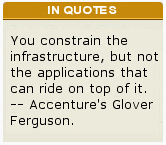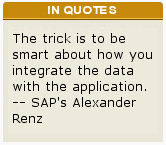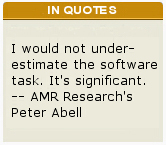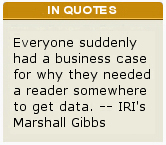March 31, 2003 – When you strip away all the hype, radio frequency identification is nothing more than another way to capture data. RFID has advantages over bar codes (you don’t need people to scan items, you can write data to some tags and so on). And it has some disadvantage (higher cost and the inconsistency of reads because of the physics of radio waves). As we’ve made clear in previous sections of this Special Report, we believe that over time, the advantages will outweigh the disadvantages, and RFID will complement and eventually replace bar codes on many items. That presents some special challenges for information technology departments.
RFID will lead to not just much more data flowing into a company, but the data will be arriving in real time or near-real time. It will be the IT department’s job to figure out how to turn all that data into information business managers can use to make better decisions. In the longer term, the systems themselves may have to make routine decisions in order to keep pace with the data. In this installment of our Special Report, Low-Cost RFID: The Way Forward, we look at the short-, medium- and long-term effects RFID will have on IT departments.
The first challenge facing CIOs today is convincing CEOs, in a time of tight budgets, to spend money on a technology that may be a couple of years away from being ready for widespread deployment. But starting early may be the single biggest thing any company can do to ensure it is able to capitalize on the long-term potential of RFID (see Getting IT Right).
Building infrastructure presents some special challenges for companies. Think of a city that decides to build an underground rail system. It has to choose the right type of system for the population’s needs, figure out how to phase in different lines, and minimize disruption to city life. It also has to plan for unpredictable growth.
Creating an RFID infrastructure poses similar challenges. One key is deciding on what type of RFID technology to adopt. It’s essential to adopt technology that works in your company’s environment. Products with a lot of water content — shampoo, juices, fruit and so on — are more easily tracked with high-frequency tags. But if you need a longer read range, UHF might be more suitable. You also need to look at the evolution of the system. You don’t want to adopt a system that works great for pallets and cases but which you might have to rip out in five years as you move to item-level tracking.
And as you evaluate the technology that is best for your company, you also have to look at what technology is, or is likely to be, adopted by your suppliers and/or customers, and by industry at large. If possible, you want to try to adopt the technology that is likely to get the broadest adoption. That’s because the more widely the technology is used, the more economies of scale will drive down unit prices for everyone.
Benetton recently announced plans to use 13.56 MHz technology from Philips Semiconductors. Since Benetton controls its own supply chain, it doesn’t have to worry about using the same systems as its suppliers. Still, supporters of the Auto-ID Center’s Electronic Product Code (EPC) technology say Benetton made a mistake because EPC technology will be more widely used that the ISO 15693 technology it chose, and therefore EPC tags and readers will eventually be cheaper.
Benetton may have hedged its bets. By adopting technology available today, it gets a lead on its competitors. At the same time, it has options in the future. Philips is also working on an EPC-compliant chip and reader makers say it would be easy to upgrade the firmware in the ISO 15693-compliant readers to make it EPC-compliant. Companies would be smart to choose technology that doesn’t lock them in to one system or another.
Once a decision is made on what infrastructure a company is going to adopt, the important thing is to ensure that everyone in the company adopts the same system. “CIOs need to be sitting at the table when line of business managers come up with ideas so the CIOs can make sure there is a common infrastructure,” says Glover Ferguson, chief scientist at Accenture. “Many big manufacturers have discovered that they have seven or eight different RFID applications running in various parts of their operations, all on different infrastructure. It’s like the client server days when we had islands of automation.”
Ferguson suggests that CIOs set rules about what type of infrastructure can be used to ensure interoperability throughout the company. “You constrain the infrastructure, but you don’t constrain the applications that can ride on top of it,” he says. “That’s where you strike the balance between centralization and innovation and decentralization.”
The analogy of RFID as an extension of the Internet is useful because it helps businesspeople to look at RFID as part of the corporate infrastructure, rather than as just a tool that is used to solve a problem here and a problem there. So CIOs need to envision what the company might look like and what benefits it might get when that infrastructure is pervasive. They need to sell CEOs on that vision. But they also need to think about the quick wins companies can get in the near term. In the next installment of this Special Report, we’ll look at where companies can look for those quick wins.
Companies may need to upgrade hardware and software before undertaking a serious operational pilot. Otherwise you will spend millions of dollars trying to solve problems created by the additional data RFID provides. We know of one company that spent $5 million on hardware and $15 million to support it because the systems weren’t in place from the beginning.
Last year, when Chep was starting a large pilot at a 280,000-square-foot facility in Florida, Jack Sparn, the pallet company’s CIO, told RFID Journal that he had to upgrade the local area network in the facility. The reason was not because the existing LAN couldn’t handle the capacity, but rather because it couldn’t handle the speed of the transactions. “You don’t want to slow down the forklift because the driver has to wait for a computer to respond,” he said.
If you have an 802.11 wireless LAN in your warehouse, you probably won’t need an upgrade. Those who have run pilots say that tracking pallets and cases with RFID tags produces about 30 percent more data. Some companies say they had to upgrade servers in the warehouse and add storage capacity, but the costs were not extravagant.
One problem with most pilots is they test the ability to read the tags, but they don’t tie into existing IT systems. So companies wind up with little understanding of how RFID will improve their operations and how it will affect their IT systems and their business processes. Tracking goods with unique serial numbers instead of bar codes will require changes to existing software, and its not easy to make changes to enterprise applications just for a pilot.
“I would not underestimate the software task,” says Peter Abell, director of research for AMR Research’s retail practice. “It’s significant to figure out how to handle data structures and what you do with a lot of information that you never had before. We’re working with a number of retailers on their content repositories and what they should do about their item master file data structures.”
Many companies, at least initially, will treat RFID tags like bar codes that broadcast information. That is, they will ignore the unique serial number and pull only data that matches their current bar code structures from the tag. That strategy may work in the short term as software vendors revamp their software to add new fields for the unique serial numbers. But even then companies face some significant software challenges as they move from tests to deployment. That’s because of the physics of radio waves.
It’s commonly said that one big advantage RFID has over bar codes is that the data will be 100 percent accurate. In many circumstances, that won’t be true. For instance, if you create a pallet with a variety of products and some items on the outside have metal foil packaging or high water content, it won’t be possible to read every item on that pallet as a forklift moves it through a portal.
Companies will have to devise procedures to get around some of the limitations of radio waves. We know of one company that is experimenting with a turntable. The pallets are stacked on a turntable and then spun around. Readers positioned around the turntable flood the pallet with RF until all items are read. Then, the pallet gets shrink-wrapped. That may work, but when that pallet arrives at the back of a store, will the retailer just accept that the items that are supposed to be on the pallet are there? Or does the retailer put the pallet on its own turntable and try to read every item?
Radio waves enable RFID tags to be read automatically. But radio waves are easily distorted, deflected, absorbed and interfered with. For instance, you could have UHF readers on a dock door. When someone walks into the reader field, waves could bounce off the person’s metal belt buckle and cause a false read two dock doors away. Even an item sitting on a shelf may disappear momentarily and then reappear.
And it’s not just the problem of false reads. A forklift driver may place a pallet in a truck. A reader at the bay may pick that up. But then the driver may remove the pallet, turn it around and put it on again. The system could record that two pallets have been put on the truck. So the system needs to figure out that, in fact, it was the same pallet.
It’s likely that the problem of false reads and false movements will need to be corrected by software systems. There are a growing number of middleware products designed to link RFID and sometimes other data-capture devices, aggregate data and pass it on to enterprise systems. Some of these products do some filtering and some don’t. (We will examine the products in more detail in a future article.) But it’s unlikely that middleware will ever compensate entirely for misreads, so companies will need to devise strategies and procedures for dealing with the problem.
In the medium-term, a major issue will be sorting out what data you need, where you need it and when you need it. If you have a shelf reader in a stock room, it may ping tags on product every 30 seconds. As cases are removed, should the inventory be updated immediately? Or is enough to store that information locally and update the inventory every hour or even every day?
Software systems connected to the readers will need to be able to manage thresholds. That is, you will have establish triggers for data to be passed on. For example, a reader on a smart shelf that tracks perfume might not forward information until a certain number of items are taken from the shelf or a certain percentage of items are in the wrong place. “The trick is to be smart about how you integrate the data with the application, so the data is provided when the application needs its it for backend process,” says Alexander Renz, director of SAP’s global product marketing.
Another issue is how and where to store data. Particularly with goods that could be recalled, such as meats, companies would want to have a complete record of a product’s movements, so they can trace the product from the source. But you’ll want to store as much information as possible at the local level and then make sure it can be retrieved when needed. This will eventually require a considerable investment in hardware, even though storage prices continue to drop dramatically.
Some applications will require item-level data, such as anti-counterfeiting, on-shelf availability and consumer loyalty programs. But in many cases, companies will be able to store information at the batch number level, or the handling unit level (pallet 123, for example). Companies will need to figure out which applications require a high level of granularity and which don’t.
In the longer term, RFID will evolve from being a talking bar code to being a means of fundamentally changing the way companies and supply chains operate. Instead of manufacturers pushing products to retailers, retailers will pull product from manufacturers based on real-time demand signals. And companies along the supply chain will be able to react in real time to what’s happening on the ground.
Many routine transactions will eventually be automated. For instance, when a shipment is delivered from a manufacturer to a retail distribution center, the moment the tags on the pallets and/or cases are read, that should trigger an invoice and start the billing process automatically. Fully automating routine processes like these are the key to boosting productivity for both supplier and retailer.
Similarly, companies will need to automate many routine decisions by using software agents. SAP has shown off a replenishment application that forecasts potential out of stocks and signals for more goods to be sent, which triggers an automatic replanning cycle. Smart IT departments will try to work with line managers to embed intelligence in software systems. If companies don’t do this, then all the real-time data in the world won’t improve their operations because people will not be able to react quickly enough.
And IT departments will have to rethink their own processes to ensure that they can keep systems running 99.99 percent of the time. If software systems are making decisions about when and where to ship product, then a server going down means product may not get shipped. That can’t happen, so IT departments will have to upgrade to servers with fail-over capability. Redundancies will need to be built into the system, from the readers up to the enterprise systems.
And just as the CIO starts as something of a policeman, who ensures the integrity of the infrastructure, he may end up as a policeman making sure that the infrastructure doesn’t quickly get out of control. Marshall Gibbs, CIO at Information Resources, was CIO at CSX when the railroad industry adopted RFID a decade ago to track rail cars. He says that once the initial infrastructure was in, it started to take on a life of its own.
“Everyone suddenly had a business case for why he or she needed a reader somewhere to get data,” he says. “That created an exponential burden on the transaction processing systems in terms of the volume running through. I see that happening to retailers and manufactures.”
RFID presents huge opportunities for companies, and huge challenges for IT departments. The keys to success are starting early and having a vision for what the infrastructure will look like when RFID is pervasive.





